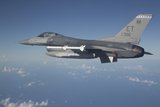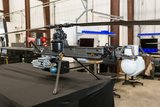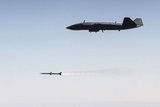Dutch $691 million request for Sidewinder missiles approved
RNLAF F-16s carry Sidewinder missiles. (Photo: Dutch Ministry of Defence)
The US State Department has approved the sale of 246 AIM-9X Sidewinder Block II tactical short-range air-to-air missiles to the Netherlands under a Foreign Military Sale deal worth around US$261 million.
As well as the missiles, the deal includes six AIM-9X Block II Sidewinder captive air training missiles (CATM), two AIM-9X Block II Sidewinder special air training missiles, 14 AIM-9X Block II Sidewinder tactical guidance units and two AIM-9X Block II Sidewinder CATM guidance units.
Also included are ancillary equipment and services such as missile containers, spares, personnel training and training equipment, US Government and contractor engineering, technical and logistics support services, and other related elements of logistics and programme support.
Related Articles
Romania approved for $340 million Sidewinder purchase
In May, the US State Department approved the sale of 300 Sidewinder AIM-9X Block II AAMs to Romania in a deal worth an estimated $340.8 million which, like, the Dutch sale, includes a range of CATM and other equipment and services.
In March, Italy requested 28 more Sidewinder Block II+ missiles from the US on top of the approximately 1,000 AIM-9s already delivered, a request worth an additional $90 million. In the same month, Poland requested 232 of the missiles, while South Korea requested 42 missiles and other systems in November last year.
The orders and approved sales, as well as other missile orders, have placed pressure on Raytheon supply chains, especially in the area of rocket motor manufacture.
In July, the company highlighted its challenges in this area and announced that it had signed a deal with Avio to “to initiate and progress the development of critical solid rocket motors for defence applications” in the same month.
More from Air Warfare
-
![Anduril UK and GKN Aerospace collaborate on British Army ACP bid]()
Anduril UK and GKN Aerospace collaborate on British Army ACP bid
The pair will submit their demonstrator concept for Project Nyx, a development project for the British Army’s Land Autonomous Collaborative Platform.
-
![US Army command’s Picatinny CLIK common lethal drone interface makes progress]()
US Army command’s Picatinny CLIK common lethal drone interface makes progress
The Picatinny Common Lethality Integration Kit is designed to overcome the issue of unique integration methods between lethal payloads and drones as well as avoiding problematic acquisition conditions created by vendor lock.
-
![Australia invests extra A$1.4 billion in MQ-28A Ghost Bat after successful missile fire test]()
Australia invests extra A$1.4 billion in MQ-28A Ghost Bat after successful missile fire test
The investment includes new contracts for six MQ-28A Ghost Bat aircraft, as well as provisional funds to invest in the development of a Block 3 prototype.
-
![Northrop Grumman to fly new Project Talon CCA by late 2026]()
Northrop Grumman to fly new Project Talon CCA by late 2026
The newly unveiled collaborative combat aircraft looks to strike a balance between capability and cost-effectiveness, according to the company.
-
![MBDA and Lockheed move closer to F-35A Meteor flight tests]()
MBDA and Lockheed move closer to F-35A Meteor flight tests
Following the completion of successful ground tests, one more exercise remains before flight testing can begin.
























